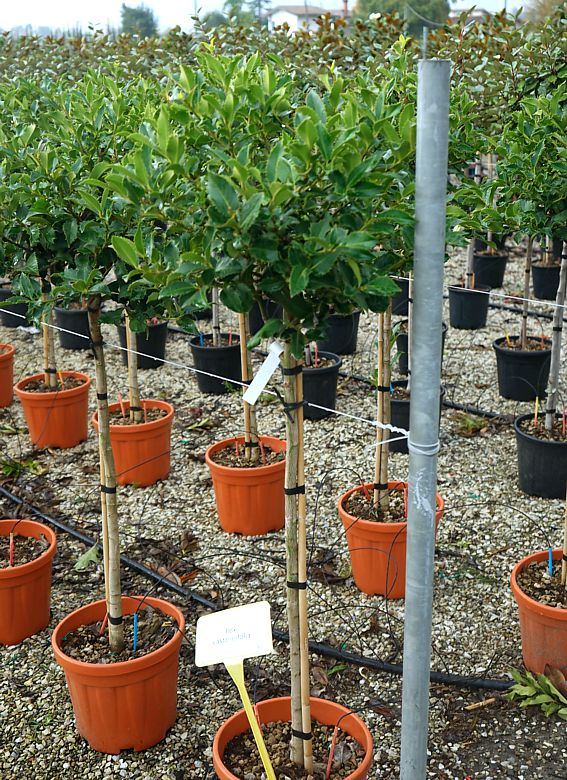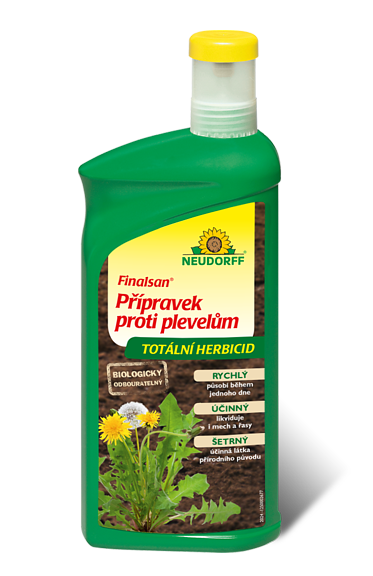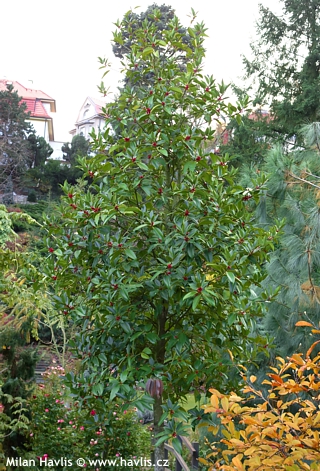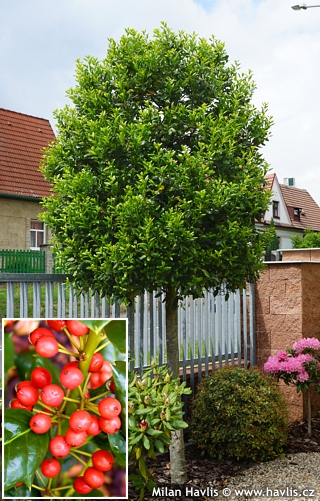Ilex x koehneana (syn. 'Castaneifolia') 'CHESTNUT LEAF' Koehne holly - female - STANDARD TREE
Ilex
Koehne holly is a less known hybrid between ilex aquifolium (English holly) and ilex latifolia (large leaf holly) which for some reason is not widely cultivated in European nurseries. I call it a pity. And since I love all evergreen plants and especially those with large leaves, it makes sense that this holly will receive a more thorough description as well as good promotion.
Chestnut Leaf is probably the most common variety when you happen to come across a Koehne holly in Europe early 21st century. I am giving this date deliberately in case you are reading this article in 2050 or later, laughing how come that we used to be so deprived having just one Koehne holly then. Anyway, back to the subject. Its name reckons there is a similarity to sweet chestnut leaves which I can only confirm. The leaves are up to 15 cm long, broadly elliptic, distinctly serrated or even short-spined at margins, rich green, and glossy. Unlike sweet chestnut leaves these are leathery and evergreen, just like leaves of most hollies. It is a female variety that, if a male pollinator is nearby, bears vivid red berries in drupes just bellow the youngest leaves close to the ends of every branch.
Under ideal conditions, e.g. in Benelux countries and England, it may grow almost 10m tall, whereas in our zone 6 it makes a symmetrical, narrowly conical shrub or small tree that seldom exceeds 4-5m tall and 3-4m wide in maturity, and grows moderately or at slow growth rate. It can be pruned and shaped to maintain smaller size. Do not cut into old wood. It takes a considerable amount of time to repair its shape. Pruning in April will encourage new growths, trimming by end July is ideal for shaping.
Tree forms of evergreen woody plants are becoming more and more popular. They can offer good screening at a desirable height blocking views from neighbouring windows if privacy is why you look for an evergreen tree. As every standard tree it needs a good support to protect the stem from moving, especially in wind. It can be removed after 3 years if the tree is established well. There is usually a bamboo stick attached to the tree trunk when you buy the plant. It needs to be removed before you tie the stem into your new support.
Grow hollies in moist but well-drained, light, and fertile soil. They can take periods of drought once established. Hollies do best in full sun but can also grow in the shade where they may lose shape. They hate compacted and clay soil nearer the top of the ground, we therefore suggest using a mycorrhizal fungi when transplanting it, and regular feeding with organic fertilizers for at least 3-4 years before it fully establishes. If you live in a region with cold winters and long-lasting frost, we recommend growing it in position sheltered from drying winds, and preferably shaded from winter sun. Chestnut Leaf holly is hardy to USDA zone 6, but it can possibly take a little more for a limited period of time.
Last update 25-12-2016; 01-03-2022

2 545,75 Kč

4 335 Kč
Goods are shipped all over Europe. For Russia and U.K. and for further details please read about SHIPPING OPTIONS HERE.
Are you interested in a serious discount for orders NOV-FEB? Check your options here.
THE PRICES INCLUDE VAT of 15%. For quick conversion you can use 1 CZK = approx. 0.04 EUR
- STANDARD QUALITY - Plants of this group are 1st class quality with number of branches and overall density adequate to their size and age, considering they were container grown.
- DE LUXE QUALITY - This label guarantees a luxurious quality of manually selected plants that, compared to their height and age, are exceptionally dense and beautiful.
- EXTRA - These plants are usually mature and bigger specimens with exceptional overall appearance.
- STANDARD (as described in the plant form) means a tree with a trunk of 190-210 cm and a crown at the top, unless specified differently. The commercial size for trees is their girth measured in the height of 1m from ground.
- HOBBY - These plants are of the same quality as our standard-quality plants but younger and therefore cheaper.
- SHRUB - a woody plant with branches growing bushy from the ground level.
- HALF-STANDARD or MINI-STANDARD - a small tree with shorter trunk, its size is usually specified.
- FEATHERED - These are trees with branches growing already from the base of the trunk and up along the stem.
- GRASSES and PERENNIALS - Sizes given usually read the diameter of the pot or the clump, as specified.







































